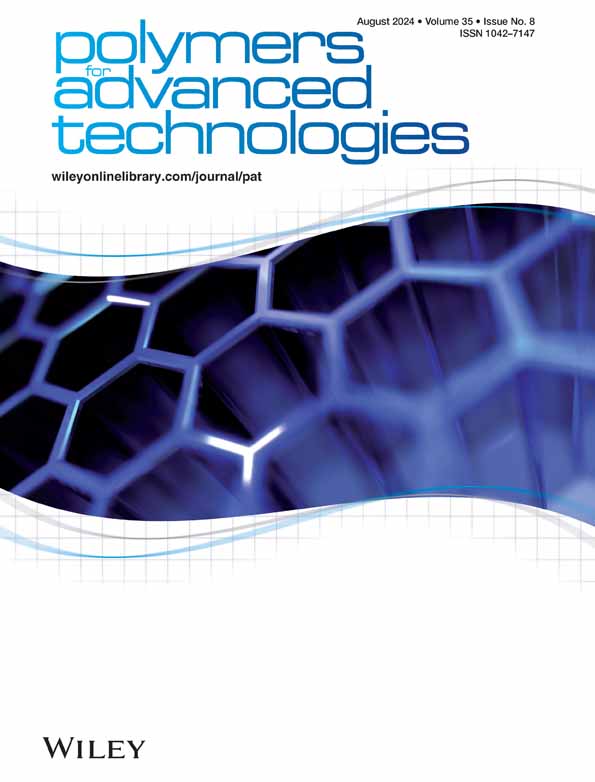Design of interconnected graphene loaded thermoplastic elastomeric blend composite films for minimizing electromagnetic radiation and efficient heat management
IF 3.4
4区 工程技术
Q2 POLYMER SCIENCE
引用次数: 0
Abstract
In this work, electrically conductive thermoplastic elastomeric blend composite films based on polystyrene (PS)/ethylene‐co‐methyl acrylate (EMA) filled with functionalized graphene were developed via the solution mixing technique. Morphological analysis revealed that selective localization of amine‐functionalized reduced graphene oxide (G‐ODA) sheets in the EMA phase of co‐continuous binary blend formed a well‐connected dense conductive pathway by graphene sheets ultimately facilitating the double percolation phenomenon. The electrical percolation threshold was achieved at ~2 wt% of G‐ODA loading which was much lower than that for both single polymer composites. An electrical conductivity of 0.9 S/cm was obtained for blend composite film with 10 wt% of graphene concentration whereas for the same filler loading, PS and EMA composites exhibited electrical conductivity of 1.9 × 10设计相互连接的石墨烯热塑性弹性体混合复合薄膜,以最大限度地减少电磁辐射并实现高效热管理
本研究采用溶液混合技术,在聚苯乙烯(PS)/乙烯-丙烯酸共聚物(EMA)的基础上开发了填充功能化石墨烯的导电热塑性弹性体共混复合膜。形态学分析表明,在共连续二元共混物的 EMA 相中,胺功能化还原氧化石墨烯(G-ODA)片的选择性定位形成了石墨烯片连接良好的致密导电通路,最终促进了双渗流现象。在 G-ODA 含量约为 2 wt% 时就达到了电渗阈值,这比两种单一聚合物复合材料的电渗阈值都要低得多。石墨烯浓度为 10 wt% 的共混复合薄膜的电导率为 0.9 S/cm,而在相同的填料添加量下,PS 和 EMA 复合材料的电导率分别为 1.9 × 10-1 和 2.3 × 10-1 S/cm。添加 10 wt% G-ODA 的混合复合材料的热导率为 0.95 W/m K,与纯混合体系相比提高了 400%。同一种复合材料的实透射率和虚透射率分别提高了 92% 和 83%。电渗流阈值与从储能模量和热导率数据中发现的渗流浓度密切相关。在石墨烯含量为 10 wt%、样品厚度为 0.5 mm 和 1 mm 的 X 波段频率(8.2-12.4 GHz)下,制备的 PS/EMA 混合物复合膜表现出吸收主导型电磁干扰 SE,分别为 -25 dB 和 -35 dB。
本文章由计算机程序翻译,如有差异,请以英文原文为准。
求助全文
约1分钟内获得全文
求助全文
来源期刊

Polymers for Advanced Technologies
工程技术-高分子科学
CiteScore
6.20
自引率
5.90%
发文量
337
审稿时长
2.1 months
期刊介绍:
Polymers for Advanced Technologies is published in response to recent significant changes in the patterns of materials research and development. Worldwide attention has been focused on the critical importance of materials in the creation of new devices and systems. It is now recognized that materials are often the limiting factor in bringing a new technical concept to fruition and that polymers are often the materials of choice in these demanding applications. A significant portion of the polymer research ongoing in the world is directly or indirectly related to the solution of complex, interdisciplinary problems whose successful resolution is necessary for achievement of broad system objectives.
Polymers for Advanced Technologies is focused to the interest of scientists and engineers from academia and industry who are participating in these new areas of polymer research and development. It is the intent of this journal to impact the polymer related advanced technologies to meet the challenge of the twenty-first century.
Polymers for Advanced Technologies aims at encouraging innovation, invention, imagination and creativity by providing a broad interdisciplinary platform for the presentation of new research and development concepts, theories and results which reflect the changing image and pace of modern polymer science and technology.
Polymers for Advanced Technologies aims at becoming the central organ of the new multi-disciplinary polymer oriented materials science of the highest scientific standards. It will publish original research papers on finished studies; communications limited to five typewritten pages plus three illustrations, containing experimental details; review articles of up to 40 pages; letters to the editor and book reviews. Review articles will normally be published by invitation. The Editor-in-Chief welcomes suggestions for reviews.
 求助内容:
求助内容: 应助结果提醒方式:
应助结果提醒方式:


